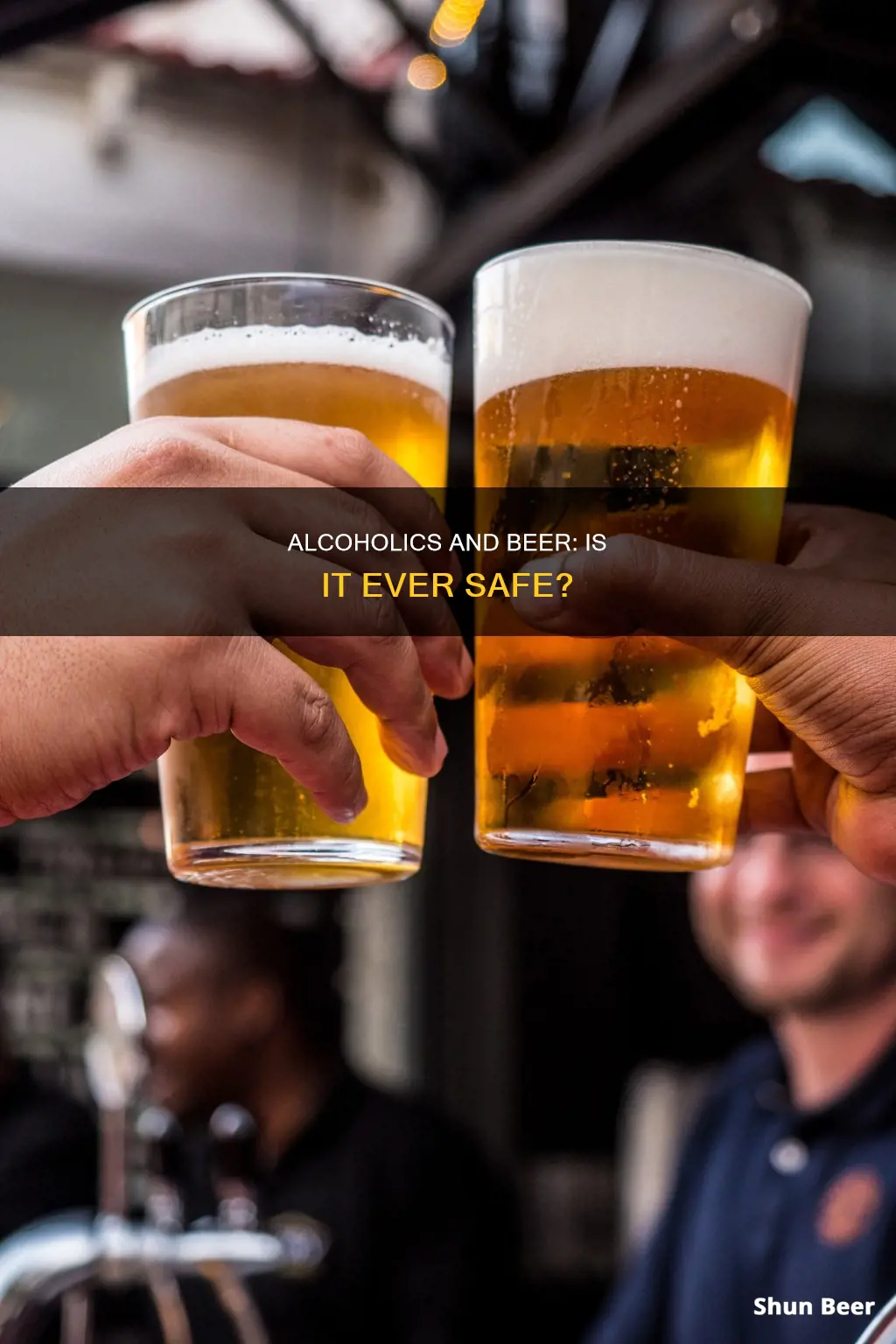
Alcoholism, or alcohol use disorder (AUD), is defined by a craving for alcohol that cannot be controlled, and withdrawal symptoms when without it. Many people with AUD are curious about whether they can drink non-alcoholic beer.
Non-alcoholic beer is a type of beer that has very little or no alcohol. It is usually produced by removing the alcohol from regular beer, and in the US, it can contain up to 0.5% alcohol by volume (ABV).
Some people believe that non-alcoholic beer can provide a valuable alternative for those looking to moderate their alcohol intake, without committing to total abstinence. However, others argue that it can be dangerous for people in recovery, as it may trigger cravings and cause a relapse.
There are pros and cons to drinking non-alcoholic beer when you are an alcoholic. On the one hand, it can help people feel included in social situations and allow them to enjoy the taste of beer without compromising their sobriety. On the other hand, the smell and taste of non-alcoholic beer may be enough to trigger a relapse for some individuals.
Ultimately, the decision to drink non-alcoholic beer during recovery is a personal one. It is important for individuals to be aware of their triggers and to avoid high-risk situations.
| Characteristics | Values |
|---|---|
| Alcohol content | Non-alcoholic beer contains very little or no alcohol. By law, non-alcoholic beers can have up to 0.5% ABV. |
| Taste and smell | Non-alcoholic beer often smells and tastes similar to alcoholic beers. |
| Benefits | Non-alcoholic beer can be a valuable alternative for people looking to moderate their alcohol intake. It can help recovering alcoholics feel included in social situations and allow them to enjoy the taste and sensation of drinking alcohol without compromising their sobriety. It also has health and relaxation benefits, being made from natural ingredients with fewer preservatives and added sugars. |
| Risks | Non-alcoholic beer may trigger a relapse in recovering alcoholics. The smell, taste, and ritual of drinking can stimulate the reward centres of the brain and release dopamine, causing cravings for real alcohol. It may also trigger "euphoric recall", where the individual romanticises their previous drinking and forgets the negative consequences. |
What You'll Learn
- Non-alcoholic beer may contain up to 0.5% ABV, so it's not completely alcohol-free
- The pros of non-alcoholic beer for alcoholics include helping them feel included in social situations and providing a path to ultimate sobriety
- The cons of non-alcoholic beer for alcoholics include the risk of triggering a relapse and the potential for a placebo effect of intoxication
- Some people view non-alcoholic beer as a valuable alternative for those looking to moderate their alcohol intake, while others see it as a dangerous loophole that could hinder recovery
- Recovering alcoholics must weigh the risks and benefits of consuming non-alcoholic beer and make an informed decision based on their own triggers and recovery journey

Non-alcoholic beer may contain up to 0.5% ABV, so it's not completely alcohol-free
Non-alcoholic beer is often marketed as a safe alternative to alcoholic drinks. However, it is important to note that non-alcoholic beer may still contain small amounts of alcohol. By law, non-alcoholic beer can contain up to 0.5% alcohol by volume (ABV). This means that non-alcoholic beer has around one-tenth of the alcohol content of regular beer. While this is a very small amount, it is not completely alcohol-free.
The amount of alcohol in non-alcoholic beer can vary, and it is important to check the labels before consuming. Some products may claim to be alcohol-free, but it is important to read the fine print and check the ABV percentage. It is also worth noting that some studies have found that non-alcoholic beers may contain more alcohol than what is listed on the label. Therefore, it is always a good idea to err on the side of caution when consuming non-alcoholic beverages.
For individuals who are trying to quit drinking or reduce their alcohol intake, non-alcoholic beer may be a helpful alternative. It can provide a similar taste and sensation to regular beer without the same level of intoxication. However, it is important to be aware of the potential risks associated with non-alcoholic beer.
One risk is that the taste and smell of non-alcoholic beer may trigger cravings for alcohol in recovering alcoholics. The ritual of drinking beer, such as cracking open a can or bottle, can also be a trigger for some people. Additionally, non-alcoholic beer may lead to "euphoric recall," where individuals romanticize their past drinking and forget the negative consequences. This can weaken their commitment to sobriety and increase the risk of relapse.
Another risk to consider is that non-alcoholic beer may not be suitable for everyone, especially those with liver impairments. Research has found that individuals with liver impairments may have higher blood alcohol levels after consuming non-alcoholic beer. This means that they may test positive on alcohol tests, even if they have not consumed any alcoholic beverages.
In conclusion, while non-alcoholic beer may be a helpful alternative for some people, it is important to be aware of the potential risks. It is not completely alcohol-free and may trigger cravings or lead to unintended consequences for individuals with liver impairments. It is always a good idea to read labels carefully and make an informed decision about whether non-alcoholic beer is right for you.
Corn Syrup in Beer: Does It Work?
You may want to see also

The pros of non-alcoholic beer for alcoholics include helping them feel included in social situations and providing a path to ultimate sobriety
Non-alcoholic beer can be beneficial for people with alcohol use disorder (AUD) in several ways. Firstly, it can help them feel included in social situations where alcohol is typically consumed. For instance, having a non-alcoholic drink can help them fit in at social events and avoid feelings of isolation and exclusion. This is especially important in early recovery when such feelings are common and could contribute to a slip or relapse.
Additionally, non-alcoholic beer can act as a path to ultimate sobriety for some individuals. For those who are not yet ready to commit to total abstinence, non-alcoholic drinks can provide a valuable alternative and help them moderate their alcohol intake. It gives them the ability to occasionally enjoy a drink while still keeping sobriety as an attainable goal. Furthermore, non-alcoholic drinks can create a space for people to begin restricting their drinking and addressing their addiction. In some cases, individuals may find this approach attainable and rewarding, ultimately choosing total abstinence.
However, it is important to note that non-alcoholic beer may also pose risks for people with AUD. The smell and taste of these drinks may trigger cravings and lead to a relapse. Therefore, it is crucial for individuals to be aware of their triggers and make informed decisions about consuming non-alcoholic beverages during their recovery journey.
Beer and Keflex: Safe Mix or Health Risk?
You may want to see also

The cons of non-alcoholic beer for alcoholics include the risk of triggering a relapse and the potential for a placebo effect of intoxication
The Risk of Triggering a Relapse
The smell and taste of non-alcoholic beer may be enough to trigger a relapse in some individuals. The ritual of drinking, such as cracking open a can or feeling the weight of a condensation-beaded glass, can stimulate the reward centres of the brain to release dopamine. This can cause a craving for alcoholic drinks, leading to a devastating relapse.
The concept of "near beer" or "euphoric recall" can be dangerous for recovering alcoholics, as it may trigger selective memories of the good times of drinking, while conveniently forgetting the negative consequences. This can cause a significant weakening in their commitment to sobriety.
Additionally, the act of drinking non-alcoholic beer may lead to a slippery slope, where one thing leads to the next, and an innocent act can result in a terrible relapse.
The Potential for a Placebo Effect of Intoxication
Some individuals have reported experiencing a placebo effect of intoxication after drinking non-alcoholic beer. Although they consumed no alcohol and were not actually drunk, they felt an actual "buzz" that could trigger a dangerous craving for more.
The sensation of drinking an alcohol-like drink can also trigger "euphoric recall", where individuals selectively remember the good times of drinking and forget the negative consequences. This can weaken their commitment to sobriety and lead them to believe that they can now manage to drink in moderation.
In conclusion, while non-alcoholic beer may provide benefits for some individuals, it is essential to consider the potential risks it poses for recovering alcoholics. The decision to consume non-alcoholic beer should be based on an honest evaluation of one's triggers, commitment to sobriety, and control over old habits.
Mixing Beer and Acetaminophen: What You Need to Know
You may want to see also

Some people view non-alcoholic beer as a valuable alternative for those looking to moderate their alcohol intake, while others see it as a dangerous loophole that could hinder recovery
The debate surrounding non-alcoholic beer as a viable option for those looking to moderate their alcohol consumption is a contentious one. While some view it as a valuable alternative, others believe it poses a significant risk of hindering recovery.
The Benefits of Non-Alcoholic Beer
Non-alcoholic beer is often marketed as a healthier, sober alternative to regular beer, providing an option for those looking to reduce their alcohol intake without sacrificing the taste and experience of drinking beer. This can be especially appealing to those who are "sober curious" or aiming to lead a sober lifestyle while still wanting to socialise in drinking environments.
For those struggling with alcohol addiction, non-alcoholic beer can provide a sense of normalcy and help them feel included in social situations without compromising their sobriety. It allows them to enjoy the ritual and sensation of drinking beer without the same risks associated with regular beer. Additionally, non-alcoholic beer is often made with more natural ingredients and fewer preservatives, making it a healthier option.
The Risks of Non-Alcoholic Beer
However, the risks associated with non-alcoholic beer cannot be overlooked, especially for those in recovery from alcohol addiction. Even though non-alcoholic beer contains significantly less alcohol than regular beer, it is important to note that it still contains alcohol. According to federal law, non-alcoholic beer can contain up to 0.5% alcohol by volume (ABV), which is the legal maximum. This means that consuming a large amount of non-alcoholic beer could still result in a small amount of alcohol intake, which may be dangerous for those in recovery.
The taste, smell, and ritual associated with non-alcoholic beer can also trigger cravings and lead to a relapse for those in recovery. The sensory experience of drinking non-alcoholic beer may be similar enough to regular beer to stimulate the reward centres of the brain and release dopamine, potentially leading to a dangerous craving for more. Additionally, the concept of "euphoric recall" may come into play, where individuals selectively remember the good times of drinking and romanticise their previous drinking habits, downplaying the negative consequences.
Weighing the Risks and Benefits
Ultimately, the decision to consume non-alcoholic beer during recovery depends on the individual's unique situation and their ability to assess their triggers and high-risk situations. While non-alcoholic beer may provide a sense of normalcy and help with social inclusion, it is crucial to prioritise sobriety and avoid any potential triggers that could hinder recovery. Each person must carefully consider the benefits and risks of non-alcoholic beer and make an informed decision based on their own recovery journey.
Non-Alcoholic Beer: Safe for Liver Disease Patients?
You may want to see also

Recovering alcoholics must weigh the risks and benefits of consuming non-alcoholic beer and make an informed decision based on their own triggers and recovery journey
Non-alcoholic beer is often marketed as a safe alternative to alcoholic drinks. However, it is essential to be aware of the risks, especially for those recovering from alcohol use disorder. While non-alcoholic beer typically contains very little to no alcohol, some products may contain up to 0.5% alcohol by volume (ABV) and, in some cases, even exceed this amount. This can pose a risk for individuals in recovery, as the smell and taste of beer may trigger cravings and increase the risk of relapse.
The decision to consume non-alcoholic beer during recovery is a personal one and should be based on an individual's triggers and recovery journey. Some may find that non-alcoholic beer helps them feel included in social situations without compromising their sobriety. It can provide a valuable alternative for those looking to moderate their alcohol intake without committing to total abstinence. Additionally, non-alcoholic beer often has fewer calories and is made from more natural ingredients than its alcoholic counterpart.
On the other hand, the ritual of drinking and the sensory experience of non-alcoholic beer can trigger "euphoric recall," where individuals selectively remember the "good times" of drinking and forget the negative consequences. This can weaken their commitment to sobriety and increase the risk of relapse. Furthermore, the very presence of non-alcoholic beer may indicate a continued desire to drink and maintain old habits, which could be detrimental to long-term recovery.
Therefore, it is crucial for individuals in recovery to weigh the risks and benefits of consuming non-alcoholic beer. They should be aware of their triggers and make an informed decision based on their own recovery journey. While non-alcoholic beer may be a valuable tool for some, it is essential to prioritize overall health and sobriety and avoid high-risk situations.
Drinking Non-Alcoholic Beer While Driving in California: Is It Legal?
You may want to see also
Frequently asked questions
Non-alcoholic beer is not completely alcohol-free. In the US, non-alcoholic beer can contain up to 0.5% alcohol by volume (ABV). While it's highly unlikely that a person will get drunk from drinking non-alcoholic beer, it still contains alcohol. For some alcoholics, even a small amount of alcohol can be dangerous.
The smell and taste of non-alcoholic beer may be enough to trigger a relapse in some individuals. It could bring back memories of drinking and act as a "gateway" to drinking alcoholic beverages.
Non-alcoholic beer can help alcoholics feel included in social situations where alcohol is being served. It can also help them transition to sobriety by allowing them to restrict their drinking and address their addiction.







